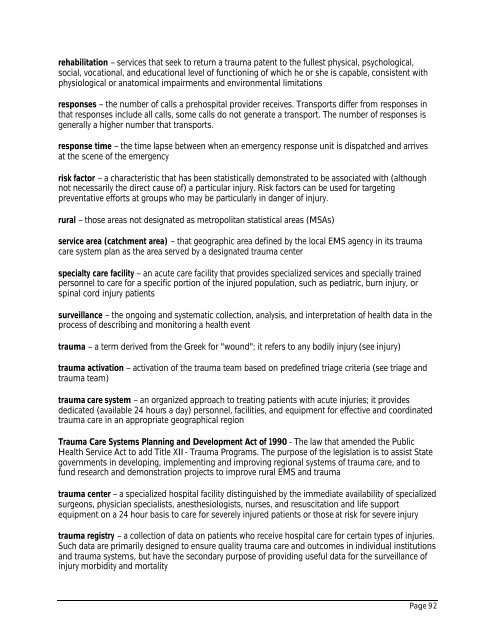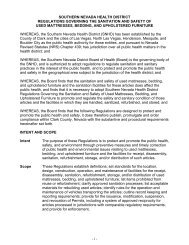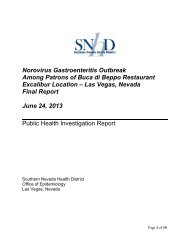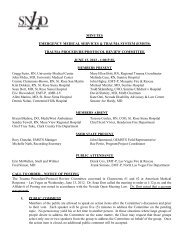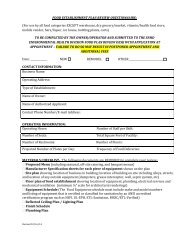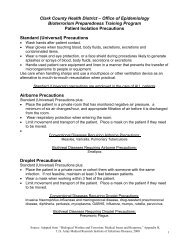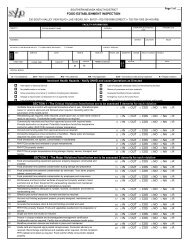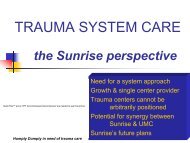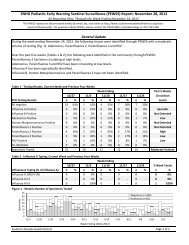Current Trauma Status Report - Southern Nevada Health District
Current Trauma Status Report - Southern Nevada Health District
Current Trauma Status Report - Southern Nevada Health District
Create successful ePaper yourself
Turn your PDF publications into a flip-book with our unique Google optimized e-Paper software.
ehabilitation – services that seek to return a trauma patent to the fullest physical, psychological,<br />
social, vocational, and educational level of functioning of which he or she is capable, consistent with<br />
physiological or anatomical impairments and environmental limitations<br />
responses – the number of calls a prehospital provider receives. Transports differ from responses in<br />
that responses include all calls, some calls do not generate a transport. The number of responses is<br />
generally a higher number that transports.<br />
response time – the time lapse between when an emergency response unit is dispatched and arrives<br />
at the scene of the emergency<br />
risk factor – a characteristic that has been statistically demonstrated to be associated with (although<br />
not necessarily the direct cause of) a particular injury. Risk factors can be used for targeting<br />
preventative efforts at groups who may be particularly in danger of injury.<br />
rural – those areas not designated as metropolitan statistical areas (MSAs)<br />
service area (catchment area) – that geographic area defined by the local EMS agency in its trauma<br />
care system plan as the area served by a designated trauma center<br />
specialty care facility – an acute care facility that provides specialized services and specially trained<br />
personnel to care for a specific portion of the injured population, such as pediatric, burn injury, or<br />
spinal cord injury patients<br />
surveillance – the ongoing and systematic collection, analysis, and interpretation of health data in the<br />
process of describing and monitoring a health event<br />
trauma – a term derived from the Greek for "wound"; it refers to any bodily injury (see injury)<br />
trauma activation – activation of the trauma team based on predefined triage criteria (see triage and<br />
trauma team)<br />
trauma care system – an organized approach to treating patients with acute injuries; it provides<br />
dedicated (available 24 hours a day) personnel, facilities, and equipment for effective and coordinated<br />
trauma care in an appropriate geographical region<br />
<strong>Trauma</strong> Care Systems Planning and Development Act of 1990 - The law that amended the Public<br />
<strong>Health</strong> Service Act to add Title XII - <strong>Trauma</strong> Programs. The purpose of the legislation is to assist State<br />
governments in developing, implementing and improving regional systems of trauma care, and to<br />
fund research and demonstration projects to improve rural EMS and trauma<br />
trauma center – a specialized hospital facility distinguished by the immediate availability of specialized<br />
surgeons, physician specialists, anesthesiologists, nurses, and resuscitation and life support<br />
equipment on a 24 hour basis to care for severely injured patients or those at risk for severe injury<br />
trauma registry – a collection of data on patients who receive hospital care for certain types of injuries.<br />
Such data are primarily designed to ensure quality trauma care and outcomes in individual institutions<br />
and trauma systems, but have the secondary purpose of providing useful data for the surveillance of<br />
injury morbidity and mortality<br />
Page 92


